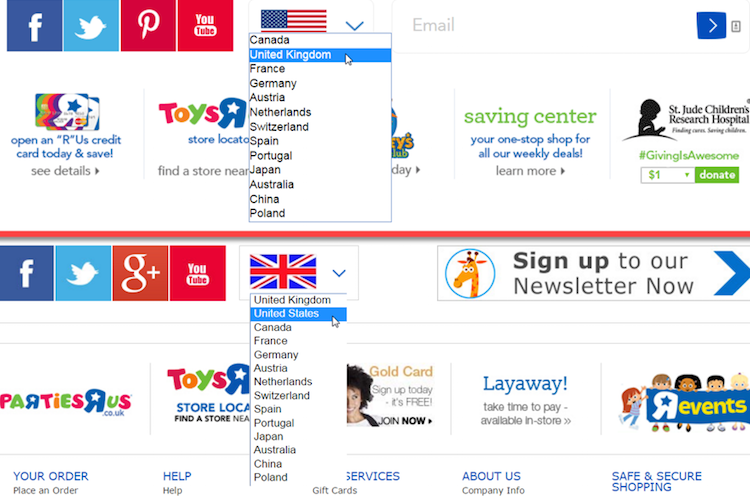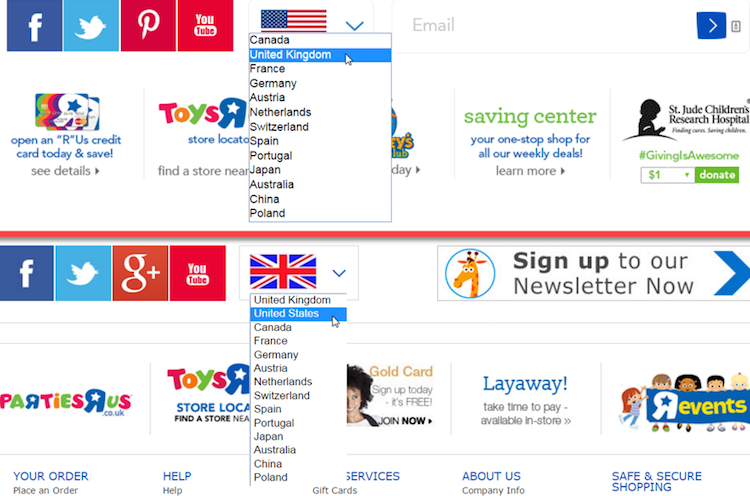Those multiple domains each act as silos, inadvertently hoarding their authority instead of sharing it with the other domains. The brand team may not allow all the brands to be hosted on a common domain. Make sure there is a strong business reason to host your sites across multiple domains. When sites do need to be hosted on separate domains, the next best option to share authority between them all is to cross link from the header or footer. Choose Your Country Offering a crawlable dropdown menu or list of links in the header or footer used across all the sites is the best way to ensure that search engine bots can navigate all the country and language sites. This is important for shoppers, but for SEO it also sends contextual relevance signals when a bot on the LEGO page in the U.S., for example, can crawl through the country selector to the U.K. and land on the equivalent LEGO page. While these typically are also accessible to search engines, they are suboptimal for SEO because only the landing page passes link authority to all the country sites, not all the pages on which the link to choose your country appears. Multiple Brands The dropdown construct described above would work for multiple brands, as well. The decision on which way to link would be strategic in this case, because Amazon would want to boost the authority of its higher-priced fashion site so that Zappos ranked higher than 6pm. In cases like this, when a landing page is necessary to display valuable information like the coupons available on Healthy Essentials’ Band-Aid page, perhaps an additional brand list or dropdown in the footer could send strong SEO link authority signals, as well.
Every domain acquires authority based largely on the quality and quantity of links pointing to it. When your business model necessitates multiple domains, harness them in a mutually beneficial linking strategy to strengthen natural search performance across them all.
Companies that operate in multiple countries or offer multiple sites for different product sets or audiences can be at a search engine optimization disadvantage.
Instead of accruing links, mentions, contextual relevance, and other positive SEO signals to a single domain where they can benefit the entire business, these signals are split between and accrue to multiple domains. Those multiple domains each act as silos, inadvertently hoarding their authority instead of sharing it with the other domains.
There are times when separate domains are necessary, however. The website platform or other backend systems may not support the requirements for all the individual countries or brands, requiring instead that separate sites be created. The brand team may not allow all the brands to be hosted on a common domain.
Make sure there is a strong business reason to host your sites across multiple domains. If there’s not, consider making the argument to migrate them to the same domain — carefully and strategically — during the next major site redesign or replatform.
When sites do need to be hosted on separate domains, the next best option to share authority between them all is to cross link from the header or footer. Before you dismiss this as an ugly design option that user experience and creative teams will never agree to, consider the following examples of effective and attractive methods of cross linking sites. One of them could work for you.
Choose Your Country
Offering a crawlable dropdown menu or list of links in the header or footer used across all the sites is the best way to ensure that search engine bots can navigate all the country and language sites. If many languages and countries are available, the list can become long and unsightly, making a location dropdown usually the more attractive solution.
In addition to enabling navigation that both bots and shoppers can access, a dropdown that is coded optimally will also share link authority between the different location sites from every page that the dropdown appears on. That means that every single page on every site that uses the location dropdown will be sending link authority through that dropdown to all the other sites. That’s an incredibly powerful way to share the authority that each country has collected with all the other countries for the good of the entire business.
Toys”R”Us’s implementation of the location dropdown, below, is good for SEO, in the U.S. and the U.K.

A couple of things are important in the way that Toys”R”Us has implemented the location link in the U.S. and U.K. sites. First, the dropdown menu is in the footer of the site used on every page. Second, the JavaScript used in the location dropdown is crawlable for search engine bots and passes relevance as well as authority through the JavaScript link because the links are bound to the countries’ names as anchor text.
Toys”R”Us could further nail the implementation by linking to the equivalent page on the other country’s site, instead of linking back to the home page, forcing shoppers to restart their journey to find a…

COMMENTS